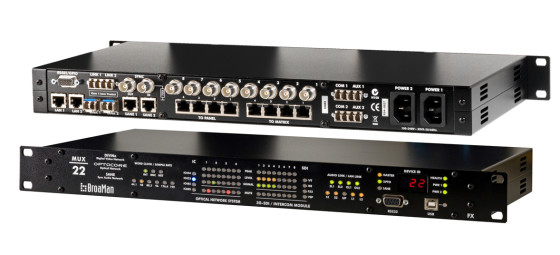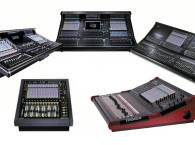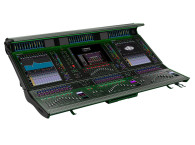
As with all Mux22 devices the Mux22 MADI supports up to eight video channels with a selectable number of dual inputs and dual outputs; it is also equipped with a Sync Board for Video Tri/Bi-Level or Audio Word Clock sync, either with RS485 or GPIO ports, and can provide fibre tunnels for any third party products.
BroaMan’s platform offers scalable and protocol independent solutions for up to 16 3G/HD/SD-SDI I/O configurable video ports with built-in CWDM multiplexer. The new MADI board is populated with four duplex SC MADI ports, offering 256 inputs and 256 outputs, and each MADI port is fully AES10 compatible, offering 56 or 64-channel MADI I/O. The audio engine is equipped with a single channel router, enabling routing from/to any MADI stream, either within the same device or between the remote Optocore, BroaMan or ProGrid devices (featuring Optocore’s optical and SanE CaT5 digital network technologies).
The complete BroaMan platform brings enormous benefits to the broadcast industry, since the digital audio option provides a complete and transparent video, audio and control transport solution. Mux-22 MADI can be used as a point to point system with any other Mux22 device, or in a star or ring topology with Route66 devices as part of a larger routing solution.
AES10 Extended with “MADI over Cat5” Standard
Meanwhile, the Audio Engineering Association (AES) is in the process of finalizing the “AES-X213, MADI over twisted-pair cabling” proposal, initiated by Optocore founder Marc Brunke, that will extend its AES10 MADI standard by allowing twisted pair Cat5 connectivity in addition to the current options.
A decade of work by Brunke has been bundled into the draft, starting in 2003 as a MADI link between Optocore’s YG2 and YS2 cards. This was followed from 2008 with an IEEE802.3 compatible version with control via regular Ethernet and PoE capability, which has since been designed into all boards and devices produced by Brunke. Now well proven for flawless performance, the final version of the extension is expected to be published by the AES in the near future. With the new standard, initiated in November 2012, simple MADI and control will be combined on a single Cat5 cable. The AES endorsement acknowledges that a twisted-pair interconnection should lead to further simplification of multichannel audio connectivity and significant cost reductions, making it suitable mainly in low but also in high channel capacity applications.
In utilizing commonly available Cat5 infrastructures it also creates a smaller footprint for device connectors, allowing for high-density connectivity. For Optocore MD, Marc Brunke, this is the culmination of a lengthy mission to make MADI more versatile and cost-effective. “With Coax and fibre optic MADI so expensive to implement, the cost advantages are obvious,” he states.
In the new standard, two pairs of Cat5 cable are dedicated to bi-directional MADI and two remaining pairs will continue to comply with the Ethernet standard. “This standard is best applied to low channel count devices like preamps and loudspeaker systems,” continues Brunke. “Companies will use it in their own designs or may wish to use our technology on an OEM basis to achieve both low cost and technical advantages.”
Currently, all Optocore R-series devices are MADI Cat5 compatible and Brunke says that 50,000 Cat5 nodes have already been sold from his licensees. He shared the idea with other manufacturers at an early stage, and some companies are now also building or offering interfaces.
Approved under AES rules, the Society states that the greater range of connectivity options will be of huge benefit to professional audio users and system developers, who can now add proven standard connectivity features at lower cost. This will thus become a natural extension of the existing AES10 MADI standard.
In summary, Brunke says, “We are very proud to offer this complete and cost effective solution to the industry as this is the bridge between low channel count and high channel count devices. Up to now, MADI has been too expensive for low channel devices, and so this new standard will change the situation drastically and will bring benefit to the industry. Also, because the new version makes MADI compatible with IEEE802.3, it can now be used in combination with other recent network standards like AES-X210 / AES-67 or older proprietary Ethernet implementations.”
www.optocore.com | www.broaman.com






